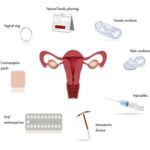In our culture, menopause is frequently seen as a negative milestone, a time of loss and is sometimes viewed as a disease or medical condition requiring a cure. With messages like this from the medical establishment and the media, it’s no wonder many health women in the midst of this transition develop negative feelings towards their bodies.
Many women gain weight during the menopause transition. This weight gain is sometimes blamed on menopause or on treatment for conditions related to menopause, including hormone therapy. However, there is no scientific evidence that menopause or hormone therapy is responsible for midlife weight gain.
What’s an average woman to expect regarding her body as she travels through her perimenopausal years (typically her mid- and late- 40s)? Should she yearn for the 30-year old physique she may once have had? Is it possible to achieve that objective? What’s a healthy and realistic goal for women hoping to optimize their body composition as well as their body image as they move through the last endocrinological change in their life?
Here are some facts. An average woman can expect to gain from two to five pounds during the menopausal transition, usually ending up in the lower tummy area. The main reason women experience this weight gain is the decline of estrogen. Fat cells in the hip, thigh and buttock areas have receptors for estrogen. Estrogen, in most women, drives most fat storage to the lower part of the body.
As estrogen levels begin to decline, however, estrogen loses its hold on fat storage below the waist and instead, fat starts to show up in the “pinch an inch” area of the waistline. It usually extends from the belly button down to the top of your pubic hairline. It’s like a small, soft pouch. I refer to this as the “menopot” and the great news is that it is not associated with life-threatening medical illnesses.
Unfortunately, many women are at risk for greater weight gain during the perimenopause and this excess fat usually is deposited deep inside the tummy, under the abdominal muscle wall. I call this Toxic Weight since this fat is unique in its ability to increase a woman’s risk for diabetes, heart disease and cancer.
A woman notices that she is fighting the tendency to shape shift from a pear to an apple. Along the way, she is may be experiencing mental frustration about the weight shifts and gains.
By menopause, most women have a rich and fulfilling life history making them prouder and wiser. However, it’s tough to focus on self-acceptance and emotional well being when your body feels like it has a life of its own and is gaining weight and getting harder to manage.
A growing number of women feel less attractive as they reach menopause. Recent American Society of Plastic and Reconstruction Surgeons statistics show cosmetic surgery has risen 47 percent for 51 to 64 year old women over the past five years. The media tells mature women to focus on “slowing down the ravages of time”, and “reducing telltale signs of aging”. These messages can affect our ideas about ourselves. The older a woman gets the harder it is to live up to the beauty standards set by an 18 year old supermodel.
So what’s the answer? Stop listening and agreeing with the media hype about negativity in the menopausal years. Reject these negative messages now. Women today have many options as they undergo natural, physical changes due to menopause. You can promote peace between your mind and body during this complex life transition.
Age and lifestyle are the main culprits.
Aging and lifestyle seem to be the primary culprits behind weight gain in women around the time of menopause. Aging is associated with slowing of the metabolism. Lean body mass decreases with age while body fat accumulates throughout adulthood. The bottom line: you have to “run to stay in place.”
Women generally become less physically active as they pass through their 40s, 50s, and 60s. Let’s face it: at any age, burning fewer calories because we are less active increases weight and fat mass. With decreased activity, muscle mass decreases.
Does menopause affect body shape?
Although menopause may not be directly associated with weight gain, it may be related to changes in body composition and fat distribution. Several studies have shown that perimenopause, independent of age, is associated with increased fat in the abdomen as well as decreased lean body mass.
This suggests that menopause plays a role in many midlife women’s transition from a pear-shaped body (wide hips and thighs, with more weight below the waist) to an apple-shaped body (wide waist and belly, with more weight above the waist) (see figure). However, further study is needed on the exact role of menopause in body composition.
Menopause is thought to play a role in many women’s midlife transition from a pear-shaped body to a more apple-shaped body.
Regardless of the different contributions of aging and menopause to weight gain and body composition, the fact is that most women in North America are overweight at midlife. Any excess weight raises the risk of many diseases, including cardiovascular disease (which is particularly linked with excess fat in the abdomen), type 2 diabetes, high blood pressure, osteoarthritis, and some types of cancer (including breast and colon). Beyond their clear effect on a woman’s overall health, these conditions tend to compromise her sexual function through reduced energy, reduced mobility, poor self-image, and other factors.
Before we get started reviewing the midlife changes that can sometimes wreak havoc on a woman’s sex life, let’s define a few terms:
- Menopause is the final menstrual period, confirmed after 12 straight months without a period or when both of a woman’s ovaries are removed or permanently damaged. When menopause occurs naturally (not as a result of surgery or other medical intervention), it’s called “natural menopause.” Most women experience natural menopause between ages 40 and 58; the average age in the
developed world is 51. - Perimenopause is the transitional time immediately before natural menopause when the changes of menopause begin, and includes the 12 months after (also called “the menopause transition”). Perimenopause can last 6 years or more.
- Postmenopause is all the years beyond menopause.
Physical signs of menopause—also called perimenopausal changes—usually start during a woman’s 40s but may start earlier. Many women who experience natural menopause, however, report no physical changes during perimenopause except for irregular menstrual periods that eventually stop when menopause is reached. For other women, the irregular menstrual periods of perimenopause are accompanied by hot flashes, trouble sleeping, and/or vaginal dryness.
These and other midlife changes discussed in this section can affect your sex life and sexual function, sometimes causing distress for you and your partner
A word about myths.
Some women believe that a bit of hair thinning or an expanding waistline is a sure sign that menopause is at hand, but that’s often not the case. Despite myths to the contrary, many of the changes discussed here are not caused solely by menopause; most result from a mix of menopause and aging, while some are due to aging alone. When possible, we have tried to tease out how much menopause and aging contribute to the midlife changes discussed here. Keep in mind that the exact contribution of each factor is not completely understood.
Here are some tips to help you get started.
Physical activity has been scientifically proven to increase body confidence and sense of pleasure in life. It is also the key predictor of healthy weight maintenance.
- Check your nutritional status. One of my patients summed this up eloquently when she said, “You know, when I eat crap, I feel like crap!” No kidding. Seems simple, yet so many of us aren’t eating healthful foods.
- Get a life! Find some activities you enjoy and start doing them. If you are lonely, seek out new forms of social support or reconnect with old friends. Make the time to do this.
- Be mindful and fully present each day. Each day is a gift just for you. Grasp the moment and enjoy.
- Take walks or hikes in nature. Being in nature is one of the best ways to reclaim the feelings of connectiveness to the world. Gardening can also be extremely uplifting for the spirit.
While menopause is a normal transition and a biological certainty, every woman’s experience is unique. Let’s take the lead from many nonwestern cultures where women look forward to the joys of aging. Drastic measures to preserve youth such as extensive cosmetic surgery are not valued in these cultures. Certainly, they should never be used as a substitute for healthy living.
Finding meaning in volunteerism and work, spending time with your family and friends, being in nature and seeing the glory in the ordinary are all roads to self and body image acceptance.
Your body is there to help you “do life” in the most meaningful way. Realizing and being thankful for this will help you appreciate, celebrate, and take care of your body.
For more information visit us our website: https://healthcaretipshub.com







No Comment! Be the first one.